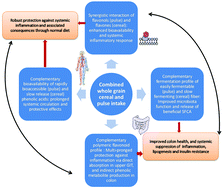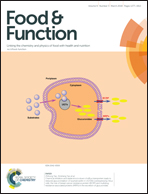Complementary effects of cereal and pulse polyphenols and dietary fiber on chronic inflammation and gut health
Abstract
Cereal grains and grain pulses are primary staples often consumed together, and contribute a major portion of daily human calorie and protein intake globally. Protective effects of consuming whole grain cereals and grain pulses against various inflammation-related chronic diseases are well documented. However, potential benefits of combined intake of whole cereals and pulses beyond their complementary amino acid nutrition is rarely considered in literature. There is ample evidence that key bioactive components of whole grain cereals and pulses are structurally different and thus may be optimized to provide synergistic/complementary health benefits. Among the most important whole grain bioactive components are polyphenols and dietary fiber, not only because of their demonstrated biological function, but also their major impact on consumer choice of whole grain/pulse products. This review highlights the distinct structural differences between key cereal grain and pulse polyphenols and non-starch polysaccharides (dietary fiber), and the evidence on specific synergistic/complementary benefits of combining the bioactive components from the two commodities. Interactive effects of the polyphenols and fiber on gut microbiota and associated benefits to colon health, and against systemic inflammation, are discussed. Processing technologies that can be used to further enhance the interactive benefits of combined cereal–pulse bioactive compounds are highlighted.



 Please wait while we load your content...
Please wait while we load your content...